Discovering Glow Garden Locations: A Complete Guide
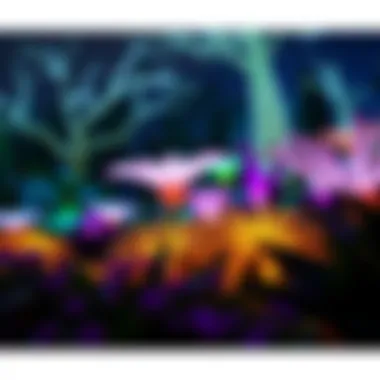
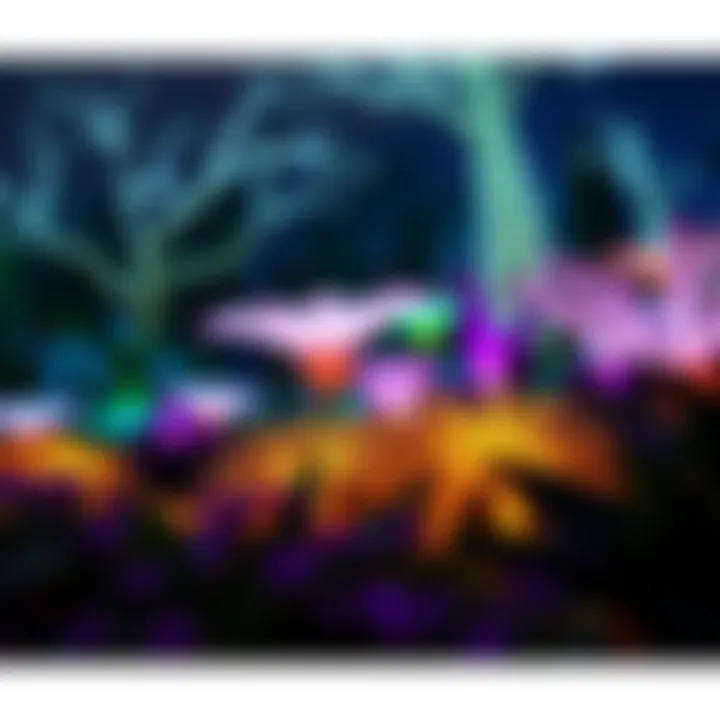
Intro
Glow gardens have emerged as a fascinating intersection of art, technology, and nature. These illuminating landscapes not only captivate visitors but also serve as spaces for shared experiences and reflection. As cities evolve and urban environments expand, the incorporation of glow gardens into public parks and private spaces has gained considerable traction.
In this guide, we will delve into various aspects of glow gardens, exploring key locations around the world, their aesthetic significance, and the planning considerations that influence their creation. Looking at both the artful elements and the community engagement these gardens encourage, this piece aims to inform potential visitors and planners alike.
For investors, homebuyers, agents, and managers wishing to venture into this burgeoning trend, understanding the market dynamics surrounding glow gardens is imperative. With strategic planning and insights, one can navigate the vibrant tapestry of opportunities that glow gardens present. Let’s shine a light on the essential aspects that define this unique and evolving journey.
Understanding Glow Gardens
Glow gardens captivate our imagination and sense of wonder, offering an enchanting experience that merges art with nature. Their unique ambiance transforms ordinary spaces into surreal environments filled with light and color. But understanding glow gardens goes beyond mere aesthetics; it’s about appreciating the intricate design, the historical roots, and the cultural narratives that envelop these spaces.
Defining Glow Gardens
A glow garden is essentially a landscaped area that incorporates illuminated elements, creating a vibrant visual experience, particularly during nighttime. These gardens often showcase a variety of light sources—from LED installations to luminescent plants—each contributing to an atmosphere that can evoke joy and contemplation.
Glow gardens vary widely in their designs and concepts, often tailored to reflect the local environment or cultural significance of the area. You might stumble upon a glow garden in an urban park, where technology and nature dance together, or in a botanical garden where whimsical art installations bring to life fairy tale themes.
Historical Context
To wrap our heads around glow gardens, it’s essential to consider their historical evolution. The concept of using light in garden design dates back centuries, with instances like ancient lantern festivals or illuminated landscapes in royal gardens. However, the contemporary glow garden movement particularly gained momentum in the late 20th and early 21st centuries, becoming a platform for artists and designers to express creativity through light.
For instance, the Festival of Lights in Berlin has historically showcased how light can transform a city, connecting cultural stories through luminescence. Moreover, in places like Japan, festivals such as the Nabana no Sato illuminate vast gardens with millions of lights each spring, showing the intersection of natural beauty with human ingenuity.
Cultural Significance
The cultural implications of glow gardens are vast, acting as venues for community gatherings, celebrations, and artistic expression. They often carry social or thematic narratives, representing everything from environmental awareness to local lore. This is more than just an aesthetic pursuit; it reflects deeper values and stories within a community.
In many cultures, light symbolizes hope and renewal. For instance, during Diwali, the Festival of Lights in India, intricate displays of lights celebrate the victory of light over darkness. Similarly, glow gardens can embody these themes, serving as a reminder of cultural values that celebrate connection, beauty, and shared experiences.
"Glow gardens invite us to rethink our relationship with nature and technology, challenging us to find beauty in unconventional places."
Whether you’re an investor considering a glow garden development or an enthusiast wanting to explore these radiant spaces, understanding the foundations of glow gardens is essential. Their importance lies not just in their visual appeal, but also in their ability to weave narratives that engage communities across the globe.
Key Components of Glow Gardens
Understanding the components that make up glow gardens is crucial for anyone wanting to appreciate these luminous spaces fully. Their design and functionality hinge on several key elements that blend together to create the magical aura these gardens are known for. Effective design can enhance the visitor experience significantly, inviting engagement while showcasing the beauty of both art and nature. These components often influence not just the aesthetic but also the practical aspects of creating a sustainable and accessible environment conducive to enjoying these illuminated areas.
Lighting Techniques
Lighting stands at the heart of any glow garden experience. Various techniques are employed to define the atmosphere, influence the color palette, and guide paths through the landscape. For instance, LED lights are often the go-to due to their versatility and energy efficiency. They can be strategically positioned to highlight specific plants or sculptures, giving a feeling of depth and enchantment. Fiber optics can also be employed, inserting soft glows within pathways or clusters of flowers, creating a stunning visual that captivates the audience's attention.
- Dynamic Lighting: With advancements in technology, dynamic lighting systems can change colors or intensity based on time of day or visitor interaction. This can create an ever-evolving experience that captivates returning visitors as they encounter something new each time.
- Natural Integration: Some glow gardens utilize solar-powered or bioluminescent elements, drawing viewers into a sustainable narrative that marries technology with nature. The interplay of shadows and light brings an ethereal quality that resonates deeply with observers.
Landscape Features
The landscaping in glow gardens plays a pivotal role in shaping the visitor's journey. It's more than just grasses and bushes; it’s about creating a multi-dimensional space that absorbs and reflects light elegantly. Carefully selected native plants, for example, can flourish even in artificial conditions, making them ideal for integration within glow gardens.
- Topography: A varied topography can add intrigue to the garden layout, featuring hills, valleys, and water features. Active formations often lead visitors on an adventure, prompting anticipation with every turn.
- Pathways: Thoughtfully designed pathways encourage exploration and are often lined with glowing elements to guide visitors. Materials such as luminescent stones or even illuminated wooden boards foster a whimsical atmosphere.
One aspect that significantly impacts the landscape's usability is its accessibility. Creating ramps and smooth surfaces means that all visitors, regardless of ability, can wander through the enchanting light displays freely.
Artistic Installations
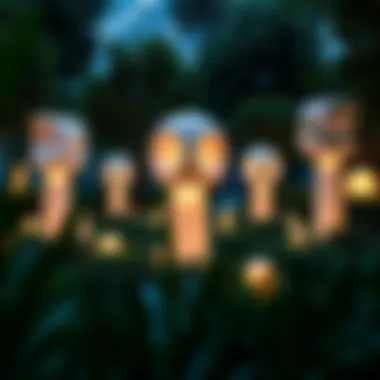

Artistic installations are the crown jewels of glow gardens, elevating the entire experience to new heights. These installations can range from giant light sculptures to intricate light tunnels. A fascinating trend is the use of local artists, whose works often reflect the cultural context of their surroundings. By involving the community, gardens not only showcase art but also foster local pride and creativity.
- Interactive Pieces: Some installations allow for visitor interaction, enabling them to manipulate lights or colors as they walk through the space. This hands-on approach deepens the connection and can leave lasting impressions.
- Seasonal Art: Temporary installations keep the garden evolving. For instance, during certain festivals or seasons, unique art pieces can transform the space. These seasonal changes offer fresh experiences to returning visitors and can be a source of great marketing potential for the gardens.
"Artistic installations not only beautify a space but also evoke emotions and provoke thoughts in ways that purely natural elements cannot."
In summary, each component plays an integral role in shaping the visitor's experience in glow gardens. From the enchanting lighting techniques to the thoughtful landscape features and innovative artistic installations, all work in concert to create an immersive, luminous experience that invites exploration and appreciation.
Notable Glow Garden Locations
Exploring notable glow garden locations is crucial to understanding the enchanting realm of luminous landscapes. These sites not only serve as recreational spaces but also foster community interactions, artistic expression, and environmental awareness. When one plans a visit to these locations, they should consider several aspects, such as the unique characteristics of each site, the experiences they offer, and how they contribute to local culture.
Global Hotspots
Asia
Asia shines brightly on the global glow garden map, with locations like the Glow Garden in Seoul, South Korea, attracting flocks of visitors. The integration of vibrant light displays with local flora is a hallmark of this region. One key characteristic of Asia is its diverse climate and rich plant life, contributing to an overall sense of wonder. Notably, the gardens display a dynamic use of traditional motifs, seamlessly blending them with modern technology. This juxtaposition not only beautifies the gardens but also enlightens visitors about local heritage. However, the challenge remains with urban spaces, where land availability prompts innovative vertical gardening solutions, maximizing limited space without compromising aesthetic appeal.
Europe
Traveling to Europe introduces visitors to stunning examples of glow gardens, with notable mentions like the Amsterdam Light Festival in the Netherlands. This event transforms the city into an open-air gallery of illumination, showcasing the brilliance of artistry combined with extraordinary architectural landscapes. A defining fact about Europe is its historical sites, often incorporating natural elements that enrich the experience. Visitors find themselves captivated by the enchanting views at night, where historical landmarks resonate with modern artistic expressions. Conversely, during winter months, some locations can face harsh weather which may limit visitor access, but advancements in design ensure exhibitions are both functional and inviting despite these challenges.
North America
North America offers a wealth of glow garden experiences, from the famous ZooLights in Chicago to the enchanting displays at the Atlanta Botanical Garden. A significant aspect of this region is its focus on sustainability within the glow gardens. Many venues incorporate eco-friendly practices, making them appealing not only for their visual splendor but also for their dedication to preserving the environment. This dual focus on environmental responsibility and attractive design positions North America as a leader in innovative glow garden practices. However, visitors must be cautious about seasonal variations; certain events are highly anticipated but only operate specific months of the year.
Unique Local Destinations
Local glow gardens offer distinctive charm that sets them apart from their larger, more commercial counterparts. Whether it’s a community-driven event or a small garden infused with local culture, these destinations can provide a unique experience. Often driven by local artists and volunteers, these venues celebrate the community spirit, proving that sometimes the smallest glow gardens can shine the brightest.
Factors Influencing Glow Garden Locations
The allure of glow gardens isn’t just their radiant beauty; the selection of their locations significantly contributes to their overall experience. As we dive into the factors influencing these enchanting sites, we discover how environmental elements, accessibility, and weather play crucial roles in crafting an immersive experience. Understanding these factors can benefit investors, planners, and visitors alike, ensuring these gardens not only bloom beautifully but also resonate with the surrounding community and landscape.
Environmental Considerations
When choosing a location for a glow garden, understanding the environment is paramount. These spaces thrive in natural settings that enhance the luminescent features and botanical innovations. Sites rich in native flora, for instance, allow the vibrant lights to interact with the natural landscape, creating visual harmony.
Moreover, one must consider soil quality, the natural ecosystem, and biodiversity. Areas blessed with diverse plant life support better interactions between light installations and nature, fostering a more enriching visitor experience. Environmental factors such as pollution levels also cannot be overlooked. Less polluted areas tend to provide clearer skies, enhancing visibility and the overall aesthetic appeal of light displays.
- Native Plants: Incorporating local species not only contributes to the garden's theme but also supports local wildlife.
- Soil Quality: Ensuring a healthy soil environment ensures the longevity and vitality of plant life, which is central to the garden’s design.
- Biodiversity: More diverse environments allow for unique artistic elements, creating a narrative around light and flora.
In summary, the environmental backdrop sets the stage for glow gardens, making it essential to select sites that marry artistic vision with ecological responsibility.
Accessibility and Transportation
A glow garden isn't just a sight for sore eyes; it must also be within reach of visitors. Accessibility is a key factor in its success. Locations need to be strategically placed near major thoroughfares or public transportation options to ensure a steady flow of foot traffic and visibility.
For many visitors, the journey to the venue can be pivotal to their experience. Simple, straightforward access means families can easily navigate their way, even on a busy weekend. Parking options further play into this equation.
- Public Transportation: Proximity to bus and train stations facilitates access for those relying on public transit.
- Parking Facilities: Ample parking helps to reduce frustration, making for a more enjoyable visit.
- Walkability: Paths leading to and around the garden should be well-maintained, inviting guests to explore at their leisure.
Investing in well-thought-out access strategies can amplify visitor engagement and, subsequently, the garden's growth.
Weather Patterns
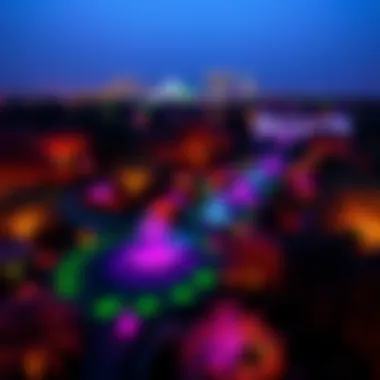
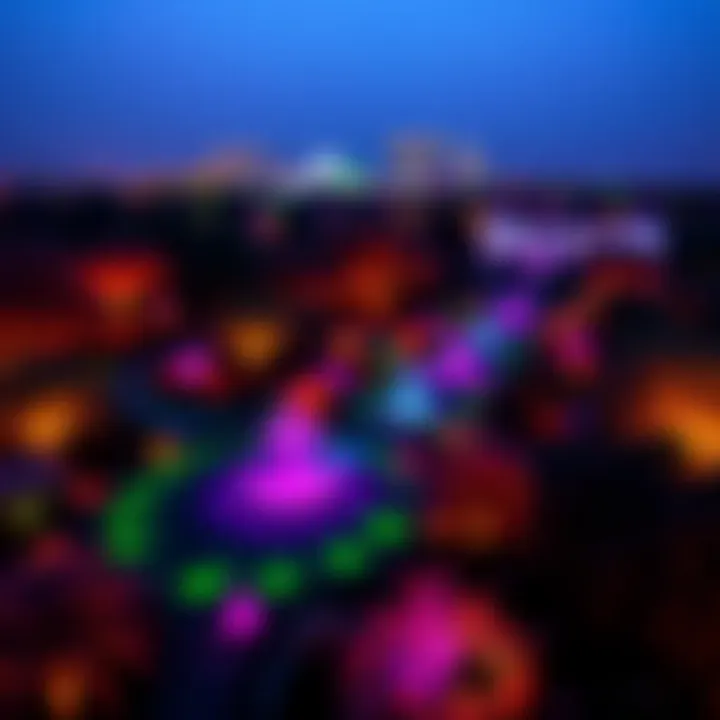
Weather conditions influence not just the garden’s flora but also the overall visitor experience. Each season brings its own charm and challenges. Knowing how weather patterns shift throughout the year allows planners to create seasonal events that keep the atmosphere dynamic.
For example, a glow garden located in a region with a mild climate can operate year-round, adapting installations to resonate with changing seasons. However, venues grasping variable patterns—like extreme winters or sweltering summers—should devise strategies to ensure visitor comfort and safety.
- Seasonality: Tailoring exhibits to specific seasons means fresh experiences for returning visitors.
- Emergency Preparedness: Gardens need plans in place for inclement weather to ensure safety.
- Visitor Comfort: Providing elements like canopies or sheltered areas can enhance enjoyment during unpredictable weather.
In shaping a visitor-friendly environment, attention to weather conditions is integral to an engaging glow garden experience, fostering lasting connections with the communities they serve.
"The combination of nature, accessibility, and environmental awareness is what ultimately transforms a glow garden from a mere attraction into a local landmark."
As we conclude the assessment of these influencing factors, it becomes clear that each element contributes not just to the aesthetic of glow gardens but also their functionality and the resonate experiences they offer to visitors.
Design Principles for Glow Gardens
Designing a glow garden goes beyond aesthetics; it's about creating an immersive experience that resonates with visitors. Thoughtful design principles shape not just the spaces but also the emotions they evoke. These principles guide planners in crafting environments that harmonize with nature, art, and technology. The right design can transform a mere garden into a refuge of light and creativity.
Creating a Harmonious Environment
A harmonious environment is crucial in glow gardens. This involves ensuring that all elements blend seamlessly. Here are key aspects to consider:
- Color Schemes: Choose colors that complement the natural landscape. Soft blues or greens can create a calming effect, while vibrant oranges or pinks might energize the space.
- Flow and Pathways: Design pathways that guide visitors intuitively. Meandering paths can instill a sense of adventure and wonder, encouraging exploration of different areas within the garden.
- Integration of Nature: Make use of native plants to enhance ecological balance. They not only adapt better but also attract local wildlife, enriching the entire atmosphere.
A well-thought-out layout not only promotes visitor engagement but also encourages a deeper connection with the glowing art installations and natural elements.
Creating harmony between light installations and landscaping not only enhances visual appeal but also contributes to the overall sensorial experience, inviting visitors to linger and interact with the setting.
Sustainability in Design
Sustainability is a core principle when it comes to designing glow gardens. By prioritizing eco-friendly practices, designers help ensure that these magical spaces are preserved for future generations. Here are some key practices to consider:
- Energy-Efficient Lighting: Opt for LEDs or solar-powered lights. This reduces energy consumption while still providing dazzling displays.
- Water Conservation: Incorporate rainwater harvesting systems or drip irrigation to manage water use sustainably.
- Recyclable Materials: Utilize sustainable materials for artistic installations. For example, bamboo, reclaimed wood, or recycled metals can create stunning visuals without further straining natural resources.
Implementing these sustainable practices can create an enchanting glow garden that not only captivates audiences today but also safeguards the environment for tomorrow. By marrying beauty with ecological responsibility, designers can craft spaces that reflect the essence of nature while glowing in the dark.
Visitor Experience in Glow Gardens
Visiting a glow garden is not just about seeing shimmering lights; it's an immersive experience that intertwines art, nature, and human interaction. This section delves into the various aspects that shape visitor experiences, emphasizing why glowing landscapes hold such appeal for a diverse audience. In recent years, glow gardens have become a case study in engaging communities, promoting local tourism, and sparking creativity.
Engagement through Interactivity
One of the defining features of modern glow gardens is the emphasis on interactivity. Visitors are no longer mere spectators; they have the opportunity to immerse themselves in the spectacle. This could be through interactive displays, digital installations, or even participation in art-making activities.
- Immersive Installations: Many glow gardens feature installations that invite guests to touch, manipulate, or change the environment around them. For instance, visitors might find themselves walking through a tunnel that lights up with each step they take, creating a personal connection to the artwork.
- Workshops and Demonstrations: Some gardens incorporate scheduled activities, such as workshops led by local artists. These allow individuals to create their own glow-inspired crafts or learn about the technology behind the displays.
- Sensory Experiences: Incorporating auditory elements enhances the engagement. Sounds synchronized with the illumination can create a truly captivating atmosphere—think of gentle whispers, rhythmic sounds, or even music that complements the visual experience.
Interactive elements ensure that each visit can be uniquely rewarding, enabling visitors to create memories they want to cherish and retell.
Events and Programs
Glow gardens often calendar a variety of events and programs designed to enrich the visitor experience. These go beyond the standard admission ticket and open opportunities for families, art enthusiasts, and community groups to connect over a shared love for creativity and illumination.
- Seasonal Festivals: Many gardens celebrate significant times of the year with special events. For example, a winter festival could feature themed installations, hot cocoa stands, and opportunities for nighttime sleigh rides, transforming the space into a holiday wonderland.
- Guided Tours: Often led by knowledgeable staff or local artists, guided tours provide a deeper understanding of the artistic intentions and technologies involved. These tours might also highlight plant life and ecological considerations within the glow garden.
- Community Nights: Some glow gardens host community nights where local residents can visit for free or at a discounted rate. These evenings can foster community spirit and encourage people to reconnect with their local environment.
- Art Exhibitions: Regular exhibitions of local artists’ works can attract different audiences and inspire future generations to explore their own creative inclinations.
By hosting a diverse array of events and programs, glow gardens become hubs of activity, ensuring that every visitor can find something captivating, educational, or simply joyful.
The fusion of light, art, and nature in glow gardens not only captivates the eye but also engages the heart, weaving rich narratives that resonate with attendees long after the lights dim.
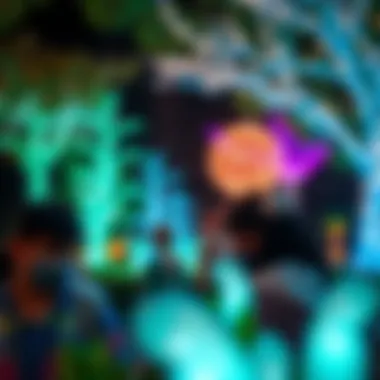

The Role of Technology in Glow Gardens
In the realm of glow gardens, technology plays a vital role that intertwines creativity with innovation. This harmonious relationship significantly influences not only how these gardens are designed but also how visitors experience their enchanting features. As we dive deeper into this topic, it's essential to grasp the specific elements that technology brings to the table, the benefits of its integration, and various considerations to keep in mind when harnessing it.
Innovations in Lighting
Lighting technology is perhaps the backbone of any glow garden. Traditional illumation methods are being replaced by advanced LED systems and fiber optics, which offer an unparalleled vibrancy and dynamic capabilities. LED lights are energy-efficient and can change colors, allowing designers to create captivating displays that dance and shift with the seasons or special events.
For visitors, this means experiencing gardens that are not just beautiful by day but transform into magical realms at night. Imagine walking through a tunnel of glowing flowers that pulse in sync with soft ambient music. This is not just lighting; it becomes a full sensory experience. Moreover, these innovations allow for intricate patterns and designs that wouldn't have been feasible with older technologies.
"Incorporating modern lighting solutions can turn a simple stroll into a mesmerizing journey through color and light."
Additionally, smart controls have taken this innovation further, allowing designers to program light displays to resonate with specific themes, occasions, or even spontaneous changes based on weather. These capabilities can elevate a garden from a mere attraction to a full-fledged entertainment venue.
Digital Art Integration
The incorporation of digital art into glow gardens is a frontier where nature and technology meet art in unexpected ways. Artists are using projection mapping to animate spaces in vibrant color, making static elements come alive as lush waterfalls or blooming flowers that seem to sway alongside the winds. Such interactive installations invite visitors to engage with the art, fostering a deeper connection with both the surroundings and the imaginative worlds created.
This approach enables a unique form of storytelling as narratives can unfold through visual displays. Each path and corner of the garden can tell a different tale depending on the projection, evoking a sense of wonder and curiosity. The fusion of physical garden elements with digital artistry encourages visitors to explore, take photos, and share their experiences on social media platforms, essentially becoming ambassadors for glow gardens.
Furthermore, as technology advances, integrating augmented reality (AR) within glow gardens is also on the horizon. Imagine pointing your phone towards a glowing flower and seeing it bloom in a vivid array of colors, or revealing hidden creatures that play a part in the thematic story of the garden. This would not only augment the visual experience but also add layers of information and interaction that take the standard garden walk to an entirely new level.
Future Trends in Glow Gardens
The enchantment of glow gardens is on the rise, captivating not just visitors but also investors and developers alike. As interest swells, it's crucial to examine the future trends shaping these luminescent wonderlands. Understanding these trends can provide insights into their potential for community enrichment, tourism growth, and innovative design techniques.
Emerging Global Trends
In recent years, a noticeable wave of glow gardens has surfaced across various continents, each embodying a unique cultural aspect while utilizing cutting-edge technology. A few significant trends include:
- Sustainability: More gardens are pledging to utilize eco-friendly materials and renewable energy sources. Instead of conventional lighting, solar-powered installations now steal the spotlight, showcasing that beauty can also tread lightly on the earth.
- Integration of Local Culture: Cities are putting local flavor in their glow gardens, showcasing traditional festivals through lights. For instance, a garden in India mirrored the intricate patterns seen in Diwali celebrations, bringing people together to embrace their heritage.
- Interactive Experiences: Visitors now desire more than spectacle; interactivity is key. Glow gardens are evolving to include augmented reality elements, where guests can engage with the installations through their smartphones, crafting a fully immersive experience.
The significance of these global trends cannot be overstated. They contribute to an increase in tourism as communities leverage the uniqueness of their glow gardens to attract visitors, thus boosting local economies.
Local Developments to Watch
With eyes on the horizon, local developments signal an exciting phase for glow gardens. Certain regions are standing out with ambitious plans:
- Community-led Initiatives: Local councils are increasingly collaborating with artists and community members to co-create glow gardens. An example lies in small towns where residents design light displays to represent their shared history.
- Seasonal Transformations: Some locations are opting for seasonal changes. During the summer, gardens may focus on bright, vibrant colors, whilst autumn can usher in warm, earthy hues, and winter might shift towards twinkling icy themes. This adaptability attracts return visitors year-round.
- Technological Collaborations: Partnerships with tech startups are blooming everywhere. For instance, a garden in California recently integrated kinetic light displays, triggered by the movements of visitors, allowing each visit to be a fresh experience.
As these local developments flourish, they echo the heartbeat of the community, creating spaces that resonate with both residents and tourists alike. The merging of art, culture, and technology stands to elevate not just the glow gardens but the overall societal joy.
"The future of glow gardens illuminates not simply landscapes but pathways to deeper community connections and personal experiences."
These interconnected trends will surely usher in a new era of glow gardens, contributing to the social fabric and economic dynamism of neighborhoods worldwide.
Culmination: The Evolving Landscape of Glow Gardens
The world of glow gardens is constantly in flux, reflecting changes not only in design and technology but also in cultural perceptions and ecological considerations. This article has traversed various aspects of glow gardens—including their unique characteristics, design principles, and the joy they bring to communities. Understanding their evolving nature is key for both visitors and planners who wish to immerse themselves in or contribute to this awe-inspiring phenomenon.
Impact on Local Communities
Glow gardens have the potential to serve as more than just ephemeral attractions; they can transform local communities. By attracting tourists, these gardens stimulate economic growth—restaurants, shops, and hotels often benefit during peak glow garden seasons. Parking lots that typically sit empty take on new life, and small businesses experience an uptick in sales. This can lead to a vibrant community atmosphere that draws in residents and visitors alike.
Furthermore, glow gardens foster a sense of community pride and engagement. Many gardens encourage local artists to display their works, which not only beautifies the space but also provides a platform for local talent. Schools and organizations might collaborate to create educational programs about sustainability or art in nature, creating social ties that are beneficial for the community at large. Seasonal events held at glow gardens often bring diverse populations together, promoting inclusivity and shared experiences.
"A garden is not just a place; it’s a community in bloom."
Final Thoughts
The shift towards glow gardens highlights a broader trend in urban planning and recreational spaces centered on merging technology with nature. As cities grow and evolve, the demand for spaces that offer aesthetic pleasure and environmental awareness continues to rise. Glow gardens exemplify how creativity can harmonize with ecological sustainability. They serve not just as a visual delight but as a reminder of human responsibility towards the health of our planet.















